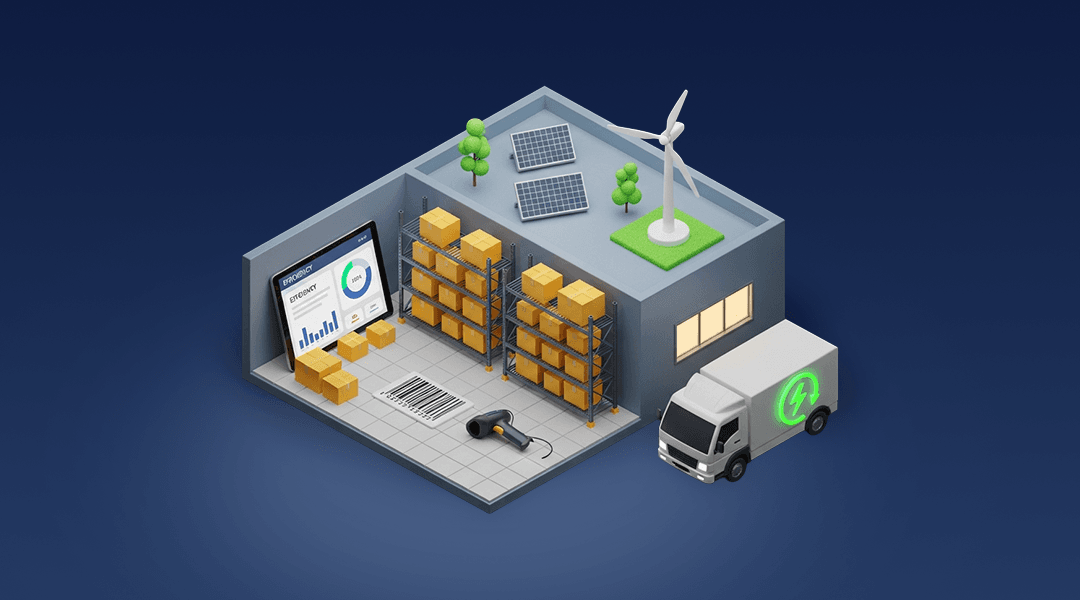Top Warehouse Statistics and Industry Trends 2025

Table of Contents
Can you believe that by 2025, more than 4 million warehouse robots will be working worldwide? In the highly competitive market, warehouses have evolved beyond mere storage spaces; they now serve as vital strategic business units. The warehousing industry is moving rapidly with fast-paced trends like automation, AI, and data-driven systems. This has changed the entire process of how goods are stored, tracked, and shipped.
By closely tracking performance and trends, companies can gain a competitive edge. In simple words, warehouse statistics help identify processes that need improvement. For example, if the metrics show your order fulfillment time as 48 hours, while the industry norm is set at 24 hours, it shows a clear need to streamline your operations. By tracking the statistics, you can easily identify barriers, spot delays, and implement automation to improve efficiency.
Warehouse industry insights will ensure that you stay abreast of developments while efficiency metrics drive operational excellence in the face of evolving global warehouse trends. In this blog, we will explore the warehouse statistics and the industry trends of 2025 to give you the insights you need to stay ahead of the competition.
Global Warehouse Trends and Key Industry Insights for 2025
The warehousing industry is undergoing rapid change and disruption. As 2025 approaches, the industry isn't just evolving—it's transforming drastically. Modern warehouses have become the nerve center for global supply chains; in other words, this is where high technology and data-driven strategies come into play.
It's time to focus on business—our warehouse statistics reveal industry insights, efficiency metrics, and global trends shaping the future of warehousing and logistics.
Global Warehouse Market Size
- The warehousing and storage market is anticipated to attain $869.32 billion by 2025, indicating consistent growth in the sector.
- E-commerce and consumer demand are expected to increase the number of warehouses worldwide to 180,000 by 2025.
- In 2020, North America had approximately 25,500 warehouses, emphasizing a sizable regional share of worldwide distribution centers.
- In 2023, the general warehouse category held almost 52% of the entire market share, highlighting the continued dominance of traditional storage and distribution services.
- Market forecasts indicate that warehousing is set to grow steadily, reaching an impressive
- The general warehousing and storage business is projected to reach $429.22 billion by 2025, highlighting significant resilience.
- Enterprise expansion in the general warehousing sector may attain $563.09 billion by 2029, indicating an increasing focus on scalable storage solutions.
- Many companies emphasize the importance of supply chain resilience, underscoring the need to withstand global shifts and changing consumer attitudes.
- Cross-border e-commerce is expected to grow by 15–20%, boosting overall warehouse demand and expanding international fulfillment centers.
- Warehousing plays a crucial role in the global economy and continues to attract mergers and acquisitions, promoting industry consolidation and technical progress.
Technology and Automation
- By 2025, around 4,281,585 commercial warehouse robots will be installed worldwide, changing how many facilities operate and manage labor.
- In 2024, the warehouse automation market is anticipated to grow from $21.42 billion to $24.09 billion by 2025, with a yearly growth rate of 12.4%.
- Warehouse automation could surpass $42.25 billion by 2029, driven by the need for real-time order processing and the growing demands of last-mile delivery.
- Warehouse Industry Insights highlights that automated solutions, such as robotics, can cut manufacturing and labor costs by 25–30%.
- By 2025, up to 50,000 robotic warehouses may be operational, increasing reliance on automated guided vehicles (AGVs) and collaborative robots.
- Fast-moving e-grocery platforms are a major driver of automated picking and AI-powered warehouse operations.
- Real-time inventory tracking is expected to become standard, helping businesses manage complex stock movements and quickly changing demands.
- Over 90% of warehouses are expected to use or plan to adopt Warehouse Management Systems (WMS), showing a shift toward greater acceptance of technology
- Predictive analytics power many operations by allowing early restocking and timely maintenance to avoid major disruptions.
- Dynamic forecasting allows agile responses across the supply chains using AI and IoT sensors to predict seasonal booms and demand changes.
Warehouse Statistics and Industry Insights
- An annual growth rate of 4.78% reflects the warehouse market's steady and consistent global expansion.
- Over 4,320 startups and companies have been established in the warehousing industry by focusing on innovative sector solutions.
- With over 137,000 patent filings, warehousing shows significant innovation.
- Currently, over 7 million individuals are employed in the global warehousing industry to meet the rising demand for tech-savvy workers.
- Warehouse technologies are growing at an average rate of 8.04% per annum, showing improvements in analytics, robotics, and automation.
- The intention to cut total emissions drives the adoption of green warehousing solutions, such as energy-efficient lighting and solar panels.
- Warehouses contribute a large share of CO2 emissions from buildings, and many are working to improve energy efficiency and reduce their carbon footprints.
- The prevalence of collaborative, multichannel distribution centers is increasing. These centers allow retailers to serve online and offline consumers from one location.
- Bonded warehousing and other specialized types are growing to make cross-border trade more cost-effective and speed up product distribution.
- Industry reports highlight 4,300 mergers and acquisitions in logistics and warehousing, reflecting ongoing investment in supply chain infrastructure.
Emerging Trends in Warehouse Management 2025
As 2025 approaches, the industry is not just evolving; it looks like a total change is happening. Modern warehouses have become the nerve center of the global supply chain with ongoing technology and data-based strategies.
It's time to get down to business; our top warehouse statistics reveal insights relevant to the warehouse industry, metrics defining warehouse efficiency that reshape global warehouse trends, and the re-engineering of logistics fabrics.
The warehousing industry is evolving dramatically. For a company to succeed, newcomers must know the global warehouse trends. Let's look at some of the latest developments through warehouse statistics analysis, key warehouse industry insights, and warehouse efficiency metrics, eventually steering global trends.
The Rise of Automation and Robotics in Warehousing
Automation and robotics are now not only familiar but also indispensable. Warehouses' rapid adoption of automation was driven by efficiency, cost-cutting, and precision. Warehouse statistics report that rising investments in automation and strategies in the robotics market have also increased the market share.
Insights from the warehouse industry state that automation improves key warehouse efficiency metrics such as fulfillment time, picking accuracy, and inventory management, which is geared towards global warehouse trends of streamlining operations.
It spans from AGVs and AMRs to advanced picking systems to AS/RS, creating an environment for automation to transform the work processes.
Sustainability Initiatives in Warehouse Operations
With growing consumer and company demand for responsible supply chain growth, sustainable practices must be established as viable businesses. As Warehouse industry insights point out, this now concerns the destruction of the environment. Warehouse statistics indicate that green certifications, renewable energy, and sustainable materials are being adopted more than ever.
Energy, waste, and emissions efficiency metrics, vis-à-vis human and environmental interactions, should rule warehouse management. Innovations such as LED lighting, solar panels, and recycling are responding to global warehouse trends. Sustainable practices help both the earth and profits.
The Impact of E-commerce on Warehousing
Electronic commerce has changed warehouses and thus demands higher orders, faster delivery, and complex fulfillment. As warehouse statistics show, the growth of e-commerce is tied to the demand for warehouse space and logistics.
This demand applied pressure to warehouses via a need revealed by Warehouse Industry Insights: to adapt to e-commerce demands for multiple SKU fulfillment, returns, and order tracking. Tracking warehouse performance metrics (e.g., fulfillment cycle time, shipping accuracy, on-time delivery) is increasingly important.
This major trend-driving force drives the emergence of micro-fulfillment, next-generation WMS technology, and best practices for last-mile operations. Understanding such trends would allow businesses to optimize operations and gain a competitive advantage in preparing for the future of logistics.
Key Warehouse Efficiency Metrics

Monitoring the right indicators is critical for optimizing warehouse operations. Some vital warehouse efficiency measures provide valuable statistics and industry insights about global warehouse trends.
Average Order Fulfillment Times
It refers to the time it takes from order receipt to shipment. The shorter the time, the better the efficiency. Warehouse statistics show a rising trend toward same-day and next-day delivery, meaning warehouses must organize their picking, packing, and shipping processes.
Inventory Turnover Rates
This refers to the sale and inventory replacement frequency in any given period. Generally, a high turnover illustrates good or efficient inventory management. According to Warehouse Industry Insights, good inventory turnover is essential to reduce storage costs and maximize profitability.
Warehouse Space Utilization Statistics
This one indicates how efficiently warehouse space is used. Higher usage rates suggest improved space management. Warehouse Statistics illustrate the rising cost of warehouse space, making optimum utilization an urgent problem. Upgrading storage layouts and using vertical storage solutions can highly increase space usage.
Final Thoughts
The warehouse sector is at a pivotal moment of opportunity. By utilizing newer solutions like automation, sustainability, and e-commerce support, industries can streamline operations to improve efficiency, profitability, and customer satisfaction.
These modern trends are backed by data. Hence, the key Warehouse Statistics and Industry Insights allow you to make rational and informed decisions. Optimizing Warehouse Efficiency Metrics maximizes your operations' potential while keeping you aligned with global warehouse trends.
Don't fall behind—partner with Omniful.ai to keep up with the fast-paced changes in warehouses worldwide. Our approach to driving automation and optimizing workflow will help you achieve new heights of excellence in your operations. Contact us for a demo!
FAQs
-
How do warehouse performance metrics affect operations?
Warehouse Efficiency Metrics have a direct impact on profits and customer satisfaction. Better KPIs, like faster fulfillment times, higher inventory turnover, and more efficient use of space, lead to lower costs, better order accuracy, and enhanced customer experiences, reflecting positive Warehouse Industry Insights.
-
What are the critical trends affecting the global warehousing industry?
Significant Global Warehouse Trends include increased automation (robotics, AI), sustainability (green practices, energy efficiency), and the constant impact of e-commerce. Warehouse Statistics reflect these changes and offer key Warehouse Industry Insights for future success.
-
What are the most crucial warehouse statistics in 2025?
The global warehouse market is expected to reach $869.32 billion by 2025, with 180,000 warehouses worldwide. Approximately 4 million commercial robots will be placed in over 50,000 warehouses, and automation adoption is estimated to lower labor costs by 25-30%.
-
How will warehouse management systems (WMS) impact businesses by 2025?
By 2025, more than 90% of businesses will automate processes using warehouse management systems (WMS). With WMS, you can easily track your inventory and multiple warehouses in real-time. This gives companies order accuracy, control, and better efficiency.
-
Are predictive analytics an essential factor shaping WMS?
Yes. Predictive analytics' data-driven insights highly improve inventory optimization. It also helps with demand forecasting, which forecasts future customer behavior and cuts overall costs.
-
What are the benefits of adopting cobots in business?
Collaborative Robots, or Cobots, are robots designed to work alongside human workers. They mainly handle physical tasks such as heavy lifting, sorting, and packaging. This lowers the risk of human injuries and makes warehouse operations more efficient.























